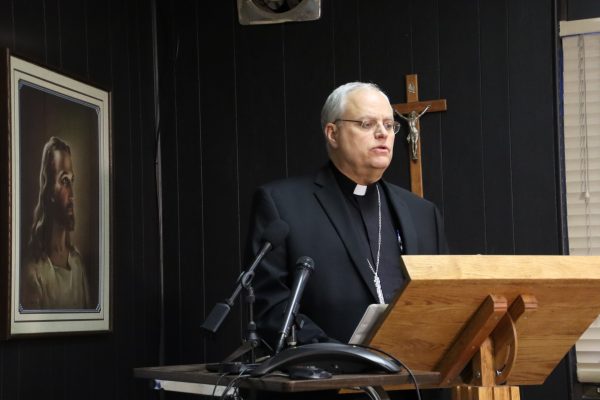
An Alaska bishop offered a series of apologies on Thursday in the wake of a review that disclosed reports of sexual misconduct by 14 men who worked for the Archdiocese of Anchorage, some stretching back more than 50 years.
All but one of the accused were priests. The abuse involved children and vulnerable adults.
At a press conference at the archdiocese in downtown Anchorage, Bishop Andrew Bellisario said he wanted those abused by clergy members to know: “It’s not your fault. It’s never, ever been your fault.”
“The pain that you suffer is the fault of others and representatives, most specifically, of the church who have perpetrated crimes upon you,” he said. “It’s with great shame that I stand here today, as a representative of the church, to offer this apology to you.”
The report released by the archdiocese Thursday detailed the findings from a review of church documents by an independent, three-person commission.
The review found “credible evidence” that 13 priests and one other church employee who served under the Anchorage Archdiocese engaged in sexual misconduct involving minors or vulnerable adults.
The men served across Southcentral Alaska from Valdez to Talkeetna to the Kenai Peninsula to the Matanuska-Susitna Valley.
Allegations against 10 of the men came while they served in the Anchorage Archdiocese. The other four served in the archdiocese but faced allegations elsewhere, the report said.
The allegations are as recent as 2015, and date back to 1956.
A search of state records appears to show no criminal charges filed in Alaska against the men, though some were named in various civil lawsuits and a bankruptcy case involving the Fairbanks diocese.
Related: Review finds evidence of sexual misconduct by 14 people in the Anchorage Archdiocese since 1966
Bellisario said the church shared the report with the attorney general’s office before posting it online Thursday.
It wasn’t clear how many of the allegations were reported to authorities by the church at the time they were recorded.
“All of these cases that needed to be reported have been reported either at the time, later or, in some cases, much later,” Bellisario said.
Bellisario said he didn’t have information Thursday on how many victims were found during the commission’s investigation. He said the commission reviewed the personnel files to create the report, and he had not.
The Anchorage Archdiocese covers 138,985 square miles — larger than the size of New Mexico. It stretches from Glennallen to Unalaska, an area with an estimated Catholic population of 32,170, according to its website.
Bellisario, the bishop of the Diocese of Juneau, is also serving as the apostolic administrator in Anchorage until a new archbishop is appointed.
Asked if the commission found that church leaders had tried to cover up the abuse, Bellisario said it didn’t “identify anybody of gross negligence.”
Read, watch and listen to our continuing coverage of abuse by priests in Alaska
“However, I think we all know — throughout the United States in particular and here, too — that if things would have been done the way we do them today, as opposed to the way they did them in the ‘70s, the ‘80s and the ‘90s, I think this list would be very, very small, possibly, maybe, even nobody on that list, which would be our goal,” he said.
He said the church now has trainings, certifications, background checks, ongoing education and additional programs.
Thursday’s report is the first time the Anchorage Archdiocese has named its clergy members who have been accused of sexual misconduct. It follows a cascade of reviews and disclosures from other dioceses across the country, including in Juneau, Fairbanks and across rural Alaska, as the Catholic Church wrestles nationally and internationally with abuse allegations and their fallout.
“The purpose of putting the names out, as many dioceses throughout the United States are doing, is to have an opportunity for people to come forward for healing,” Bellisario said. “We’re doing this for people who have been harmed. People who have been victimized.”
Bellisario encouraged people who had been victimized to consider reporting to law enforcement. He said people could also contact the archdiocese’s victim assistance coordinator.
Tegan Hanlon is the digital managing editor at Alaska Public Media. Reach her at thanlon@alaskapublic.org or 907-550-8447. Read more about Tegan here.





